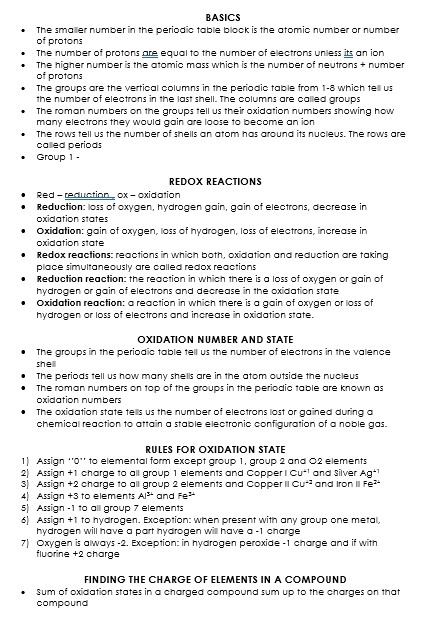The Chemistry of Metals
Summary:
This comprehensive summary covers various aspects of metal chemistry, including the basics of the periodic table, redox reactions, oxidation numbers, electrolysis, galvanic cells, smelting, extraction of metals, alloys, atomic radius, ionization energy, electronegativity, rusting, and the thermite reaction.
The basics section explains key concepts such as atomic number, atomic mass, groups, periods, oxidation numbers, and the relationship between protons, electrons, and neutrons. It also delves into redox reactions, highlighting the processes of reduction and oxidation and their associated changes in oxidation states.
The discussion on oxidation numbers and states provides rules for assigning oxidation numbers to elements in various compounds, enabling the determination of the charge carried by each element.
Electrolysis is explored as a process that uses electricity to break down ionic compounds into simpler substances. The electrolytic cell is described, emphasizing the roles of the anode, cathode, and electrolyte in the overall reaction.
The extraction of metals is covered in the context of smelting, which involves the reduction of metal oxides using carbon or other reducing agents. Specific examples, such as the extraction of iron and aluminium, are provided.
Alloys, mixtures of metals with other metals or non-metals, are discussed along with their compositions and applications in various industries.
Important concepts like atomic radius, ionization energy, and electronegativity are explained, emphasizing how these factors influence the reactivity and behaviour of elements.
Excerpt:
The Chemistry of Metals
BASICS
- The smaller number in the periodic table block is the atomic number or number of protons
- The number of protons is equal to the number of electrons unless its an ion
- The higher number is the atomic mass which is the number of neutrons + the number of protons
- The groups are the vertical columns in the periodic table from 1-8 which tell us the number of electrons in the last shell. The columns are called groups
- The Roman numbers on the groups tell us their oxidation numbers showing how many electrons they would gain are loose to become an ion
- The rows tell us the number of shells an atom has around its nucleus. The rows are called periods
- Group 1 –


Reviews